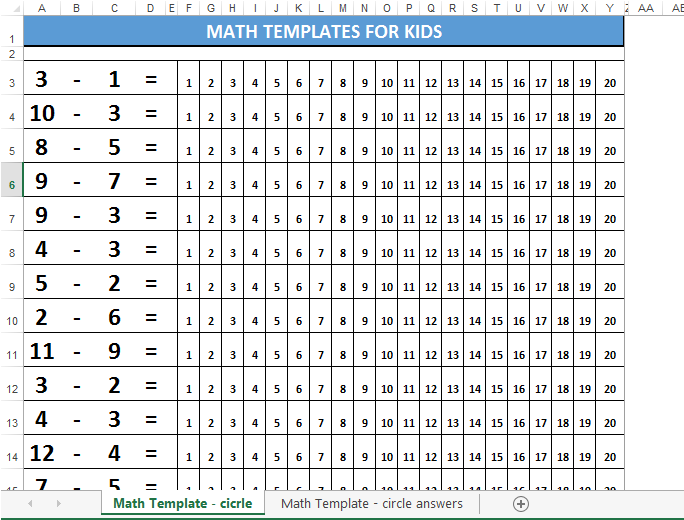Learn to subtract for kids and circle the answer
Save, fill-In The Blanks, Print, Done!

Download Learn to subtract for kids and circle the answer
Microsoft Spreadsheet (.xlsx)- This Document Has Been Certified by a Professional
- 100% customizable
- This is a digital download (30.21 kB)
- Language: English
- We recommend downloading this file onto your computer.
Are you looking for a smart and easy-to-customize template to teach your child how to subtract numbers? Get our subtraction worksheet template for kids now which is easy to follow and will help your child learn subtraction quickly and easily. Download this "Math for Kids template subtracting numbers" preschool educational template now!
Teaching kids to learn subtraction can be made engaging and effective with various strategies and activities. Here's a step-by-step approach to teach subtraction to kids:
- Start with Concrete Objects:
- Begin by using physical objects like toys, coins, or counters. For example, if you have five toys and you remove two, how many are left? This helps children grasp the concept of "taking away."
- Use Visual Aids:
- Draw pictures or use visual aids like number lines or subtraction charts to represent subtraction problems. For instance, for 5 - 2, draw five objects and cross out two to show the subtraction process.
- Number Line:
- Introduce the concept of a number line, where numbers are placed in a sequence. Use it to illustrate subtraction by moving backward on the line. For example, for 8 - 3, start at 8 and move three steps backward to 5.
- Word Problems:
- Present subtraction in the form of word problems related to everyday situations. For example, "You had 10 candies, and you ate 3. How many candies do you have left?"
- Subtraction Stories:
- Create simple stories or scenarios where subtraction is needed. Encourage kids to act out the stories with objects. For instance, "You have 7 apples, and you gave 2 to your friend. How many apples do you have now?"
- Hands-On Activities:
- Engage in hands-on activities like baking, where you need to subtract ingredients. For example, "If the recipe calls for 5 cups of flour, but we only have 3 cups, how much more do we need?"
- Use Manipulatives:
- Manipulatives like counters, beads, or cubes can help kids physically see and manipulate numbers for subtraction problems.
- Subtraction Songs and Rhymes:
- Incorporate subtraction songs or rhymes that make learning fun and memorable.
- Interactive Games:
- Use educational games and apps designed for teaching subtraction. Many digital resources offer interactive subtraction practice.
- Practice and Repetition:
- Provide plenty of opportunities for practice. Create worksheets with subtraction problems that gradually increase in difficulty.
- Flashcards:
- Subtraction flashcards can help with quick recall of subtraction facts. Practice with flashcards regularly.
- Math Stories and Books:
- Read math-themed children's books or stories that involve subtraction. This can help reinforce the concept in a narrative format.
- Real-Life Examples:
- Point out real-life examples of subtraction, such as when sharing items with siblings or friends or when dealing with money.
- Positive Reinforcement:
- Offer praise and positive reinforcement for correct answers and effort. Make learning subtraction a positive experience.
- Patience and Progression:
- Be patient and understand that children may progress at different rates. Start with simple subtraction problems and gradually introduce more complex ones as their skills develop.
- Use Technology:
- Educational websites and apps often have interactive subtraction lessons and games suitable for kids.
Remember that learning subtraction is a gradual process, and it's important to create a supportive and encouraging learning environment. Tailor your approach to the child's age, ability, and learning style, and ensure that learning subtraction is both enjoyable and comprehensible.
DISCLAIMER
Nothing on this site shall be considered legal advice and no attorney-client relationship is established.
Leave a Reply. If you have any questions or remarks, feel free to post them below.
Related templates
Latest templates
Latest topics
- Excel Templates
Where do I find templates for Excel? How do I create a template in Excel? Check these editable and printable Excel Templates and download them directly! - GDPR Compliance Templates
What do you need to become GDPR compliant? Are you looking for useful GDPR document templates to make you compliant? All these compliance documents will be available to download instantly... - Google Docs Templates
How to create documents in Google Docs? We provide Google Docs compatible template and these are the reasons why it's useful to work with Google Docs... - IT Security Standards Kit
What are IT Security Standards? Check out our collection of this newly updated IT Security Kit Standard templates, including policies, controls, processes, checklists, procedures and other documents. - Letter Format
How to format a letter? Here is a brief overview of common letter formats and templates in USA and UK and get inspirited immediately!
cheese


